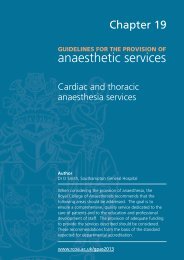INTRAVENOUS PARACETAMOL
INTRAVENOUS PARACETAMOL
INTRAVENOUS PARACETAMOL
Create successful ePaper yourself
Turn your PDF publications into a flip-book with our unique Google optimized e-Paper software.
intravenous paracetamol<br />
Safe Anaesthesia Liaison Group<br />
SALG RECOMMENDATIONS<br />
1 Intravenous (IV) paracetamol should be prescribed carefully, according to the weight, age and co-morbidities<br />
of the patient. The upper dose limit for each single dose and in each 24-hour period should not be exceeded.<br />
2 50ml vials of IV paracetamol should be used for patients less than 33kg. In infants and small children, doses<br />
should be measured accurately using a syringe.<br />
3 Enquiry about recent paracetamol ingestion should form part of routine pre-operative assessment. All doses<br />
of paracetamol administered in the operating theatre should be recorded on the ward drug administration<br />
chart and in the anaesthetic record.<br />
4 Advice should be sought from the local poisons information service in all cases of overdose of intravenous<br />
paracetamol. Treatment with acetylcysteine is suggested following a single dose greater than 60mg/kg.<br />
5 Intravenous paracetamol (Perfalgan®) remains under intensive monitoring by the MHRA. All suspected<br />
adverse reactions to IV paracetamol should be reported to the Yellow Card Scheme and discussed with the<br />
local poisons information service.<br />
Background<br />
A Fatal Accident Inquiry in Scotland in 2011 concluded that a young adult died from liver failure due to an overdose<br />
of paracetamol. The Sheriff found ‘there was, at the time of the death, a prevailing culture of assumed familiarity with<br />
the administration of IV paracetamol, a familiarity derived from the common use of oral paracetamol’. The patient,<br />
who weighed 35kg, died nine days after receiving paracetamol 1g IV on a sustained and regular basis. 1<br />
Intravenous paracetamol was licensed in the UK in 2004 and is used routinely in anaesthetic practice. Since<br />
introduction, there have been concerns about accidental overdose of IV paracetamol due to errors in drug prescription<br />
and administration, particularly in children, small adults, the elderly, alcoholics and those with pre-existing<br />
hepatocellular insufficiency.<br />
Reported errors include incorrect dose in adults with high or low body mass index; accidental overdose in children<br />
associated with use of 100ml-vials; 10-fold drug calculation errors; confusion between dose volume in millilitres and<br />
dose of drug in milligrams; errors when setting up infusion pumps; and duplication of doses between the ward and<br />
the operating theatre or recovery. 2-5<br />
Examples of recent reports to the NRLS include:<br />
➤➤<br />
➤➤<br />
➤➤<br />
Patient had a dose of paracetamol before going to theatre and then was given another dose whilst in theatre. Fifth<br />
dose in 24 hours.<br />
Paracetamol not given on the ward post op due to double dose given in theatre...<br />
Patient was given the prescribed 1gram paracetamol on the ward at 08:13hrs as part of pre-med. On return to ward<br />
after procedure it was noted on the anaesthetic chart that 1gram of IV paracetamol had been given at 09:30 hrs...<br />
The MHRA issued a Patient Safety Update in 2010 that raised concerns about accidental overdose of IV paracetamol<br />
(Perfalgan®), especially in infants and neonates. Perfalgan® is presented in a concentration of 10mg/ml, and in<br />
most cases, a 10-fold overdose was reported. The MHRA advised vigilance when prescribing and administering<br />
Perfalgan®, to adhere to recommended doses and dose intervals, to avoid concomitant administration by different<br />
routes, and to use 50ml vials for infants and children who weighed less than 33kg. 3<br />
The NPSA issued a Signal alert in 2010 that raised concern about the risk of inadvertent overdose of IV paracetamol<br />
in children, and described 206 incidents relating to IV paracetamol, two associated with severe harm and 14 with<br />
moderate harm. 5<br />
1 | May 2013
Recommended dose of IV paracetamol<br />
The dose of IV paracetamol recommended by the MHRA for children and adults is shown in the table below.<br />
Paracetamol should be given by infusion over 15 minutes, and the minimum dose interval should not be less than four<br />
hours (six hours in patients with renal impairment).<br />
Term newborn<br />
infants, infants,<br />
toddlers and children<br />
weighing 10kg and 33kg and 50kg<br />
Dose of IV<br />
paracetamol<br />
(per infusion<br />
administration)<br />
Maximum daily<br />
infusion dose**<br />
7.5mg/kg 15mg/kg 15mg/kg 1g<br />
30mg/kg 60mg/kg 60mg/kg Must not exceed 4g<br />
*The dose of IV paracetamol is controversial in neonates and infants. The BNF for Children (BNFC) suggests a dose of<br />
7.5mg/kg every 8 hours (maximum 25mg/kg daily) in preterm neonates over 32 weeks postmenstrual age, 10mg/kg<br />
every 4-6 hours (maximum 30mg/kg daily) in neonates. 6<br />
**The British National Formulary (BNF) suggests caution in patients with hepatocellular insufficiency, chronic<br />
alcoholism, chronic malnutrition or dehydration, and to administer a maximum daily infusion dose of 3g in adults in<br />
these patient groups. 6<br />
Treatment of IV paracetamol overdose<br />
Paracetamol is metabolised in the liver by glucuronidation and sulphation; a small proportion is metabolised<br />
by oxidation to toxic metabolites such as N-acetyl-p-benzoquinone-imine. Benzoquinoneimine is combined with<br />
glutathione and is excreted safely in the urine, but if glutathione stores are depleted, benzoquinoneimine accumulates<br />
and potentially fatal hepatic damage may occur.<br />
Patients in the peri-operative period may be particularly vulnerable to the toxic effects of paracetamol as it may be<br />
administered regularly over a number of days, and patients may have low glutathione levels due to starvation or preexisting<br />
nutritional deficiency. 7,8<br />
The treatment for paracetamol toxicity is IV infusion of acetylcysteine, which restores the ability of the liver to produce<br />
glutathione. Nomograms for the treatment of paracetamol toxicity are based on time since ingestion of oral paracetamol<br />
and the plasma level at four hours. Overdose with IV paracetamol poses a specific management problem, as standard<br />
nomograms cannot be directly applied. In IV paracetamol overdose plasma levels peak immediately after IV injection,<br />
and will normally be lower than predicted from the same oral dose at the same time after ingestion.<br />
Guidance on management of IV paracetamol overdose is available from the UK National Poisons Information Service<br />
(NPIS), and guidance is updated regularly on Toxbase, the database of the NPIS (http://www.toxbase.org). IV paracetamol<br />
is potentially very toxic in overdose and managing clinicians are encouraged to discuss all patients with overdose with the<br />
local poisons information service (UK NPIS, in Ireland, National Poisons Information Centre www.poisons.ie).<br />
Currently the NPIS advises acetylcysteine administration following a single intravenous dose of paracetamol above<br />
60mg/kg. Do not wait for the result of the plasma paracetamol concentration. For pregnant patients, the toxic dose<br />
should be calculated from the pre-pregnancy weight; for patients above 110kg, the toxic dose should be calculated<br />
from a maximum weight of 110kg.<br />
If the dose of IV paracetamol administered is unknown or uncertain, the treatment nomogram should be used to<br />
obtain an estimate of risk based on a blood sample taken four hours after dosing. Treatment should be initiated<br />
if plasma paracetamol is >50mg/l at four hours (i.e. half the value of the four hour plasma concentration in oral<br />
overdose). 2 Patients who present late, or with multiple doses of IV paracetamol exceeding 60mg/kg in 24 hours<br />
should be treated with acetylcysteine. Neonates are particularly susceptible to IV paracetamol overdose and treatment<br />
with acetylcysteine should be considered in all overdoses.<br />
2 | May 2013
Intravenous paracetamol is a relatively new preparation, and is under close scrutiny by the MHRA and internationally; it<br />
is recommended that all cases of adverse reaction to IV paracetamol are reported to the MHRA 3,4,9 and all cases of IV<br />
paracetamol overdose are discussed with the NPIS/NPIC so that experience of these cases can be collected.<br />
REFERENCES<br />
1 Judiciary of Scotland. Fatal Accident Inquiry into the death of Danielle Welsh (accessed 4 November 2012).<br />
2 Beringer RM, Thompson JP, Parry S et al. Intravenous paracetamol overdose: two case reports and a change in<br />
national treatment guidelines. Arch Dis Child 2011;96:307–308.<br />
3 Gray T, Hoffman RS, Bateman DN. Intravenous paracetamol – an international perspective of toxicity. Clin Toxicol<br />
2011:29:150–152.<br />
4 MHRA Drug Safety Advice. Intravenous paracetamol (Perfalgan®): risk of accidental overdose, especially in infants<br />
and neonates. Drug Safety Update 2010;3(12):2–3 (accessed 4 November 2012).<br />
5 Overdose of intravenous paracetamol in infants and children: Signal Alert 29 October 2010. NPSA (accessed 4<br />
November 2012).<br />
6 Paracetamol (acetaminophen) In: BNF for Children 2012. BMJ Group, Pharmaceutical Press, RCPCH Publications.<br />
7 Berling I, Anscombe M, Isbister GK. Intravenous paracetamol toxicity in a malnourished child. Clin Toxicol<br />
2012;50:74–76.<br />
8 Savino F, Maddalena ML, Locatelli E et al. Fulminant hepatitis after 10 days of acetaminophen treatment at<br />
recommended dosage in an infant. Pediatrics 2011;127:e494-e497.<br />
9 Dart RC, Rumack BH. Intravenous acetominophen in the United States: iatrogenic dosing errors. Pediatrics<br />
2012;129:901–902.<br />
3 | May 2013









